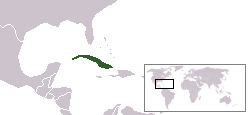Confederate Cuba

| |
| Flag of Confederate Cuba | |
| Motto: Hasta la Victoria Siempre! | |

| |
| Region | Anticapitalist Alliance |
|---|---|
| Capital | Habana |
| Official Language(s) | English and Spanish |
| Leader | Julio L. Deltón |
| Population | ~22.5 million |
| Currency | dollar |
| NS Sunset XML | |
Confederate Cuba, officially the Confederate Revolutionary Republic of Cuba , consists of the island of Cuba (the largest of the Greater Antilles), the Isle of Youth and adjacent small islands. Cuba is located in the northern Caribbean at the confluence of the Caribbean Sea, the Gulf of Mexico and the Atlantic Ocean. Cuba is south of the eastern United States and the Bahamas, west of the Turks and Caicos Islands and Haiti and east of Mexico. The Cayman Islands and Jamaica are to the south.
Cuba is the most populous country in the Caribbean. Its culture and customs draw from several sources including the aboriginal Taíno and Ciboney peoples, the period of Spanish colonialism, the introduction of African slaves, and the Confederado exodus after the American Civil War. The island has a tropical climate that is moderated by the surrounding waters; the warm currents of the Caribbean Sea and its location between water bodies also make Cuba prone to frequent hurricanes.
History
- Main article(s): History of Confederate Cuba
The history of Confederate Cuba can be traced back to January 1865, when a radical Confederate name John Wilkes Booth assassinated Abragam Lincoln to try and bolter the dying Southern cause. The Radical Republican Hanibal Hamlin promised vegence, and in March of the same year forced the Confederate States to sign the humiliating Treaty of Manasass, which resulted in a brutal Northern occupation of the South. This caused the First Exodus, where close to a thrid of the South fled, seeking assylum in Spanish Cuba.
Three years after the exodus, an uprising by the natives of Cuba took place, and Spanish troops crushed it with the help of Confederado battlions. The Confederados still looked down on the non-white population of the island, and they also had no sympathy with Cuba's non-Confederado whites. Spain answer to the rebellion was heavy oppresssion were an elite class of Spanish nobles and Confederado veterins ruled the island. The feelings of the Southeners started to turn against Spain.
After the war, many poor Spanish peasants fled to Cuba because of the favorbale condition Spaniards had on the islands, and one of these families was that of Fidle Castro.
By 1890, conditions for the average Cuban had deteriorated significantly. An American journalist visiting the island was astonished to discover a new brand of slavery against the black population by the Confederados. Native Cubans often ate once every day, if that. Finally, on November 7, the Spanish government tried to step up. It started by abolishing slavery in Cuba, and sent troops to make sure that the slaves were free. When Confederados heard of this, most shot at the soldiers, which started the Cuban War for Independance.
Confederados rallied the rest of the nation (sans blacks) against the Spanish, and a long and bloody war developed. The rebels controlled the northern parts of the island, and the Spanish held the south. The war would not come close to ending until 1898. In '98, a U.S. ship, the Maine, which was docked in Guantanamo Bay, and exploded, killing most of its crew. This led the the United States joining in on the side of the rebels, and invading Cuba, winning the war.
After the war the United States and the Confederado population finally reconciled, and immigration restrictions were lifted. Although the Reconstruction ended ten years before, few Confederados returned to their old homes. Much more Southeners, however, made the trip to Confederate Cuba.
A new Cuban Parliament was established, and rights were given to all citizens, except for full-blooded blacks, who, to the shame of the non-Confederados, were still held in slavery. The non-Confederados and mulattoes of the island started pushing for universal rights, however the Confederado bloc in the Cuban Congress was too large to make this happen. Racial equality would be a huge issue in Cuba for many years.
Cuba's democracy was unstable from the beginning, and the goverment was constantly shifting from weak republics to oppressive dictatorships. A new socialist movement finally ended the series of coups, and the Cuban Soviet General enjoyed widespread support, which increased after sweeping social reformed in 1929 dampened the effect the Great Depression had on Cuba.
The two main factions of Cuba were still bitterly split, and although blacks had been freed in 1916, they were still considered only residents of Cuba. The natives, led by Carlos Manuel de Céspedes of the Santiago Soviet, was set against the Confederados, led by Woodrow Wilson of the Habana Soviet. Corruption started to seep into the Soviet General. This corruption was highlighted in December 1932, when a devasting hurricane shattered southern Cuba's infastructure. The Soviet General, however, only debated on a trade bill and took no action. Three weeks after the hurricane, an army coup stirred by agitator Sgt. Fulgencio Baptista took over the island, and the new government suspended the Constitution.
